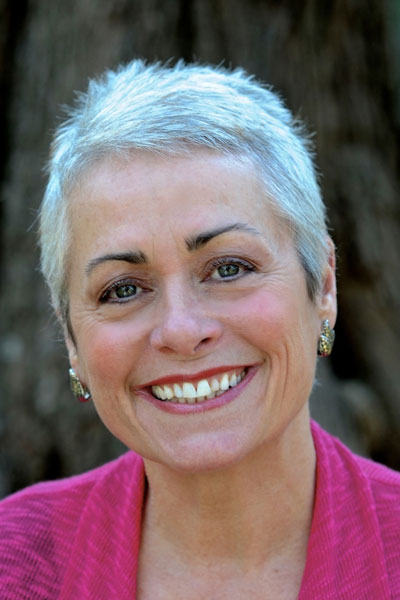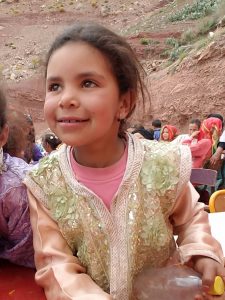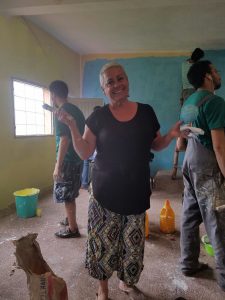
Lessons on Sustainability from a Remote Mountain Village in Morocco
As we go deeper into the country, we also move deeper into the cultural iceberg. We drag our bags through the central square of Marrakesh in the dark, accompanied by the call to morning prayers. Two hours later we arrive at a little village where we leave our bus and board a ‘renovated’ 9 passenger van for the unpaved, rocky road to a remote rural Berber village.
The inside of the van is sparse, benches with just enough padding and an old toolbox to sit on. But what it lacks in upholstery is more than made up for with fringe. Yards of velvety maroon fabric cover the cab, fringe along the edges and strategically placed tassels on the ceiling. The further from town we travel, the steeper and rockier the climb becomes. Strains of Moroccan music on the sound system don’t drown out the overworked gears on the vehicle. After a couple of unplanned stops to pile out and push the van out of sand, we arrive jostled and dusty at the entrance to our inn for the night. A ten minute climb up a dusty path to a private home ~100 feet above is rewarded with majestic views of the mountains and terraced valley below.
 The host family welcomes us with Moroccan mint tea, cookies and warm bread with olive oil and honey in a salon which will later be the women’s sleeping quarters. For now it is our communal room, furnished around the perimeter with a built-in cushioned bench covered with elegant cloth and pillows. Perfect for entertaining or sleeping with plenty of room for guests. So unlike the American approach where even the newborn baby gets her very own room. Just outside the small entrance door 12 pairs of shoes await their owners in the concrete hallway. We slip them on for a quick lesson on how to use the squat toilets and we’re off.
The host family welcomes us with Moroccan mint tea, cookies and warm bread with olive oil and honey in a salon which will later be the women’s sleeping quarters. For now it is our communal room, furnished around the perimeter with a built-in cushioned bench covered with elegant cloth and pillows. Perfect for entertaining or sleeping with plenty of room for guests. So unlike the American approach where even the newborn baby gets her very own room. Just outside the small entrance door 12 pairs of shoes await their owners in the concrete hallway. We slip them on for a quick lesson on how to use the squat toilets and we’re off.
 The steep rocky terrain in the midday heat makes our one kilometer hike to the school seem much farther. At last we see the school perched above us, within reach, and we start to hear the chanting and drum playing of our welcoming committee. About 50 brightly costumed children are dancing, singing and banging drums to welcome the hot dusty crew who have come to spruce up their school. We’re told that we are the first foreigners to visit this village.
The steep rocky terrain in the midday heat makes our one kilometer hike to the school seem much farther. At last we see the school perched above us, within reach, and we start to hear the chanting and drum playing of our welcoming committee. About 50 brightly costumed children are dancing, singing and banging drums to welcome the hot dusty crew who have come to spruce up their school. We’re told that we are the first foreigners to visit this village.
We enter a classroom spread with carpets, pillows and low tables covered with tea servers, bowls of dates and nuts, boiled eggs, bread, butter and olive oil. Joining our group are the volunteer organizers, local journalists, school administrators and town leaders. The only women present are from ASU. A microphone is passed for welcoming remarks and our professor is interviewed by the journalist. I don’t understand a word of it, but she seems to deliver a flawless interview in Moroccan Arabic.
 The children entertain us with songs and skits, followed by several courses of delicious food which we eat from a common bowl. One of the town elders, Mohamed, sits at our table, urging me to “Ish! Ish!” (“eat” in Berber Arabic). Dressed in a caftan and skull cap, he is a tall thin man with only a few teeth, a narrow pointy face and deep brown expressive eyes. I later learn he’s my age (57) even though he appears to be around 70. He tells us that the village survives off of agriculture and cattle. While it is currently a sustainable way of life, a bad drought could bring it to an end.
The children entertain us with songs and skits, followed by several courses of delicious food which we eat from a common bowl. One of the town elders, Mohamed, sits at our table, urging me to “Ish! Ish!” (“eat” in Berber Arabic). Dressed in a caftan and skull cap, he is a tall thin man with only a few teeth, a narrow pointy face and deep brown expressive eyes. I later learn he’s my age (57) even though he appears to be around 70. He tells us that the village survives off of agriculture and cattle. While it is currently a sustainable way of life, a bad drought could bring it to an end.
After lunch, the classroom is cleared and we set to work sanding walls, mixing paint and putty, and plugging cracks and holes in the wall, before painting with turquoise, white and sunshine yellow. The mood is jovial, everyone pitching in while world music plays on a dust covered sound system. I am reminded of another aspect of the village’s sustainable lifestyle which Mohammed described during lunch – Tiwisi, the practice of pitching in to help one’s neighbors. Everyone shows up to bring in the harvest, build a road, repair a house – without pay, but with the understanding that his family will also have help when it is their turn.
 But what happens when there are no opportunities to keep young people in the village? The local school only goes through sixth grade, so children must leave the village to continue their education. Hussein is the only boy from the village to graduate high school. His grandfather tried unsuccessfully to convince his daughter-in-law to send her daughter into town to continue her education. What? To be without her daughter for months? And to what end when village life for a girl is limited to raising children, cooking and cleaning?
But what happens when there are no opportunities to keep young people in the village? The local school only goes through sixth grade, so children must leave the village to continue their education. Hussein is the only boy from the village to graduate high school. His grandfather tried unsuccessfully to convince his daughter-in-law to send her daughter into town to continue her education. What? To be without her daughter for months? And to what end when village life for a girl is limited to raising children, cooking and cleaning?
We often talk of sustainability like it’s a western academic invention, yet this village has sustained a fairly comfortable way of life for almost 1000 years. But what of the future? The villagers spoke of several needs – warm clothes, accessible healthcare, new sources of revenue and opportunities to keep young people from leaving. Can they develop eco/cultural tourism in the region? How would that impact the already scarce local resources? What kind of infrastructure would be needed and what environmental/cultural impact would it have on the area? Who would profit from such an enterprise? At whose expense? These are the issues we are here to learn about and we are seeing the lives they affect firsthand.
The next morning’s bus ride back to town was much less dramatic, allowing for reflection and conversation. Passing a mule, several students began to debate the virtues of owning a mule versus a car. “The mule wouldn’t get you as far.” “Yeah, but the car would have a lot of upkeep costs. With these roads, you’d be replacing parts all the time.” “Well, you’d have maintenance with the mule too, like shoveling manure.” This was a serious conversation. About sustainability. One that I couldn’t have imagined overhearing before our Ait Khalef experience.

